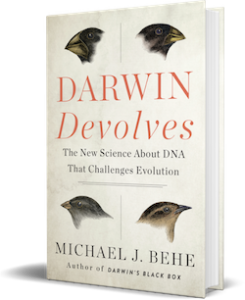 Evolution
Evolution
Unguided Darwinian Mechanism’s “Self-Limiting” Nature Is What Dooms It


The “Scientific Dissent from Darwin” list has topped a thousand PhD signers, certainly a vast understatement of the number of scientists who doubt that the Darwinian mechanism explains life’s complex wonders. This is just as the publication of biochemist Michael Behe’s book this month draws near. Behe is no lone figure, but he does stand out in pushing the envelope of the critique of evolution. In Darwin Devolves: The New Science About DNA That Challenges Evolution, he presents an even more fundamental problem than he did in his pioneering first book, Darwin’s Black Box.

On an ID the Future episode, Discovery Institute Senior Fellow Jay Richards talks with Professor Behe about his new book. Download the podcast or listen to it here.
The basic challenge is this: Unguided Darwinian evolution can accomplish a lot that’s useful, as cutting-edge gene sequencing has demonstrated. But it’s all, or almost all, evolution by destruction. Behe gives the analogy of a bridge separating you from an invading group of enemies. Blow up the bridge. You’ve thus cut off the route by which the bad guys intend to do you harm. Great! But does it tell you anything about how to build a bridge? No, not a thing.
Evolution knows how to blow up a bridge. This can confer survival advantages. Behe cites an example of people in Africa on whom a deleted protein bestows resistance to malaria. Great! But how did the protein get built to begin with? Unguided evolution can’t explain that. Building things is what we commonly think of when we think of evolution. Yet destroying them is what the Darwinian mechanism is actually gifted in doing.
“The great majority of mutations that help are in fact ones that either degrade a gene or break it outright,” says Behe. “I’ve spotted no really constructive examples of Darwinian evolution. This devolution is seen in bacteria, it’s seen in humans, it’s seen in polar bears, it’s seen in birds and fish. It’s everywhere. So you get pretty confident about your conclusions when they’re so general.”
Good at Imagining Things
But maybe, while the great majority of evolution’s accomplishments consist of devolution, the critical few that remain are what builds everything else we see in life? Jay Richards nails the problem: “The mechanism itself is self-limiting.” Darwinists are good at imagining things. If they were to imagine some few exceptional constructive mutations, those would be swamped by the destructive ones. This is one excellent reason that scientists increasingly doubt the orthodox theory with its remarkable claims of creativity.
Darwin Devolves is out on February 26. If you pre-order now, you’ll also get some fine free extras. Those include a bonus chapter about the Dover trial where the judge’s misunderstanding of the relevant science underlined an important lesson. Dover and Judge Jones offer “a better insight,” says Dr. Behe, “into the dangers of letting other people draw your conclusions for you.”
Photo credit: Sgt. G.D. Robinson [Public domain], via Wikimedia Commons.
